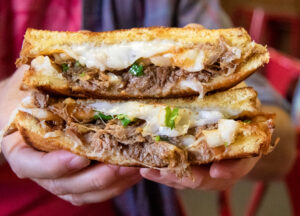“Sharing food with another human being is an intimate act that should not be indulged in lightly. “ ~M. F. K. Fisher
Cooking for friends and cooking with friends can both be successful, but – per baby boys and girls when it comes to changing diapers – require distinct sets of operating instructions. To cook collaboratively where one usually operates in isolation compels an entirely different approach to traversing the kitchen floor, to juggling pots and burners, and, of course, to wielding long, sharp, pointy metallic objects, all the while in the company of an upturned wine bottle, or three. Indeed, cooking with friends enjoins a different way of thinking about food altogether, because – no matter how much enthusiasm (and, critically, aptitude) for prep, plating and service your guests show up with – cooking for company remains an inherently solitary undertaking, while cooking with company is easily as much about the resulting social fabric as it is about the meal.
Partly, this is a function of logistics; partly, and importantly, but not principally. No, true collaboration, on one’s own home court, with another person with whom one has never shared the kitchen, demands significant measures of humility, compromise, and adaptability – three words that, truth be told, I very nearly had to spell-check, as rarely as they enter my lexicon. I am not, as a rule, much beholden to the way other people think things should be done, and I tend to cook that way. Of course, I also drive, vote, and tell anyone who will listen what I think in that way as well, so this is hardly a unique pattern; really, it’s a reasonably effective pattern, so long as I have room to maneuver and more or less know what I’m doing; the downside scenario – when certitude replaces certainty, when I’m more obstinate than resolved – isn’t pretty, but that’s a story for another post.
The thing to remember, if you invite a friend to help you cook, is that it’s a good bet that they aren’t showing up expressly for the purpose of prepping your mise or doing your dishes; no, they’ll want to contribute, preferably in some way directly related to the application of heat and knife-force to starches and proteins. They may even arrive with a dish, or at least a central component of one, already set in heart and mind, if not par-cooked and in-transit; upon arrival and ensconced with kitchen towel and some measure of accountability, they may well fail to appreciate that only you know the right way to do something.
All of which – and this, finally, is The Point – necessitates a degree of flexibility that most of us, at least those among us who spend a lot of time doing our own work in our own kitchen, generally lack: Seasoning to taste, presentation, and the menu itself – what we normally think of as our manifest culinary destiny – become, with company that cooks, a team effort. But that needn’t be a bad thing, and that really is the point of this post: To the contrary, it can mean less work for you or me; a chance to check out someone else’s chops and maybe even learn something; and – this is the key, really – the opportunity to come up with something, working together, that neither would have come up with alone.
The Do’s and Don’t’s of Cooking with Friends
MFK Fisher once said, "Sharing food with another human being is an intimate act that should not be indulged in lightly", and the same, I think, could be said for cooking food cooperatively: While cooking for friends and cooking with friends can both be successful, they require - per baby boys and girls when it comes to changing diapers - distinct sets of operating instructions.









